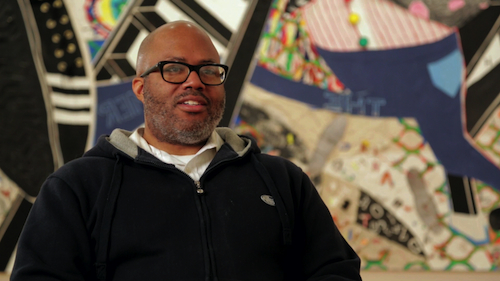
Artist Trenton Doyle Hancock. Production still from the series Exclusive. © Art21, Inc. 2013. Cinematography by Rafael Salazar Moreno.
“I went through a breakup. There were births. There were deaths. There were these very real things that caused me to reevaluate what’s worthy of my time in the studio when time is such a limited thing.”
Speaking from James Cohan Gallery, New York in late 2012, artist Trenton Doyle Hancock describes how his work has evolved over the past ten years. When Art21 first filmed the Houston-based artist in 2002, all of his paintings and drawings were filtered through a fictional narrative and characters he called “Mounds” and “Vegans.” Hancock created these stories to give structure to his wide-ranging interests and ideas. The Mounds and Vegans have appeared in numerous exhibitions, a storybook, a mural at the Dallas Cowboys Stadium, and even a ballet. It was while watching the ballet that Hancock realized it was time to move on from the tale.
The subsequent shift in the artist’s work coincided with major changes in his personal life, to which he alludes in the above quote. Thinking back on his older works, Hancock acknowledged that it held “very personal things,” but they were “really codified and hidden.” Feeling more aware of time and the finite reality of human existence, he began to insert personal details into his work more directly, without the filter of fiction. The Den (2012) is a striking example of this.
Trenton Doyle Hancock. “The Den” (detail), 2012. Production still from the series Exclusive. © Art21, Inc. 2013. Cinematography by Rafael Salazar Moreno.
From the painting’s scale and prominent placement in his 2012 exhibition “…And Then It All Came Back To Me” (2012), it was apparent that the object held incredible significance. I learned during our interview that the tile floor in his grandmother’s Texas home inspired this honeycomb pattern—this was the surface on which Hancock first learned to draw. In this new Exclusive, Hancock explains how he rediscovered the tile after having forgotten all about it: